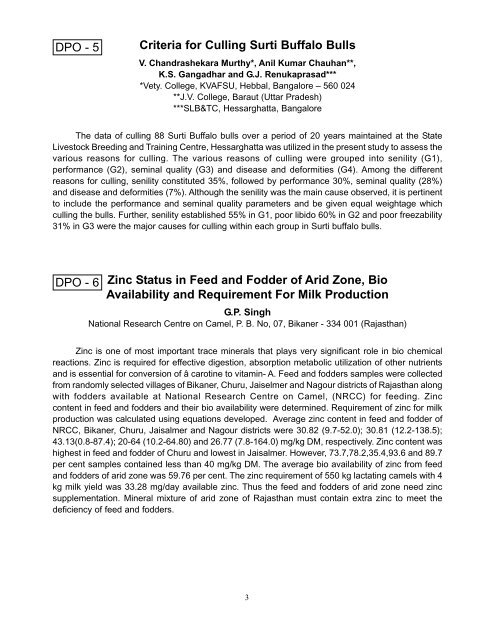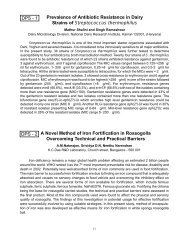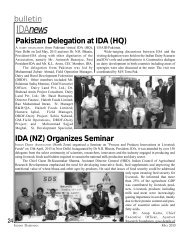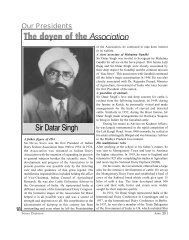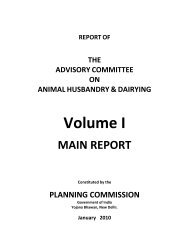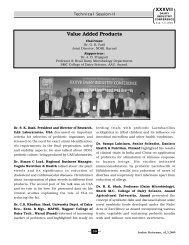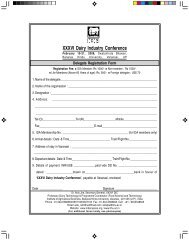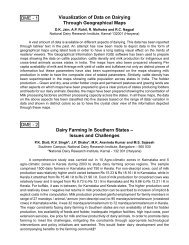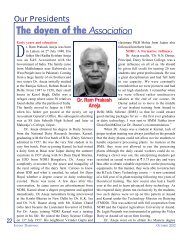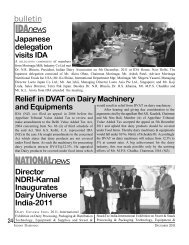Malnad Gidda Cattle - A Valuable Native Breed of Karnataka ...
Malnad Gidda Cattle - A Valuable Native Breed of Karnataka ...
Malnad Gidda Cattle - A Valuable Native Breed of Karnataka ...
- No tags were found...
You also want an ePaper? Increase the reach of your titles
YUMPU automatically turns print PDFs into web optimized ePapers that Google loves.
DPO - 5Criteria for Culling Surti Buffalo BullsV. Chandrashekara Murthy*, Anil Kumar Chauhan**,K.S. Gangadhar and G.J. Renukaprasad****Vety. College, KVAFSU, Hebbal, Bangalore – 560 024**J.V. College, Baraut (Uttar Pradesh)***SLB&TC, Hessarghatta, BangaloreThe data <strong>of</strong> culling 88 Surti Buffalo bulls over a period <strong>of</strong> 20 years maintained at the StateLivestock <strong>Breed</strong>ing and Training Centre, Hessarghatta was utilized in the present study to assess thevarious reasons for culling. The various reasons <strong>of</strong> culling were grouped into senility (G1),performance (G2), seminal quality (G3) and disease and deformities (G4). Among the differentreasons for culling, senility constituted 35%, followed by performance 30%, seminal quality (28%)and disease and deformities (7%). Although the senility was the main cause observed, it is pertinentto include the performance and seminal quality parameters and be given equal weightage whichculling the bulls. Further, senility established 55% in G1, poor libido 60% in G2 and poor freezability31% in G3 were the major causes for culling within each group in Surti buffalo bulls.DPO - 6Zinc Status in Feed and Fodder <strong>of</strong> Arid Zone, BioAvailability and Requirement For Milk ProductionG.P. SinghNational Research Centre on Camel, P. B. No, 07, Bikaner - 334 001 (Rajasthan)Zinc is one <strong>of</strong> most important trace minerals that plays very significant role in bio chemicalreactions. Zinc is required for effective digestion, absorption metabolic utilization <strong>of</strong> other nutrientsand is essential for conversion <strong>of</strong> â carotine to vitamin- A. Feed and fodders samples were collectedfrom randomly selected villages <strong>of</strong> Bikaner, Churu, Jaiselmer and Nagour districts <strong>of</strong> Rajasthan alongwith fodders available at National Research Centre on Camel, (NRCC) for feeding. Zinccontent in feed and fodders and their bio availability were determined. Requirement <strong>of</strong> zinc for milkproduction was calculated using equations developed. Average zinc content in feed and fodder <strong>of</strong>NRCC, Bikaner, Churu, Jaisalmer and Nagour districts were 30.82 (9.7-52.0); 30.81 (12.2-138.5);43.13(0.8-87.4); 20-64 (10.2-64.80) and 26.77 (7.8-164.0) mg/kg DM, respectively. Zinc content washighest in feed and fodder <strong>of</strong> Churu and lowest in Jaisalmer. However, 73.7,78.2,35.4,93.6 and 89.7per cent samples contained less than 40 mg/kg DM. The average bio availability <strong>of</strong> zinc from feedand fodders <strong>of</strong> arid zone was 59.76 per cent. The zinc requirement <strong>of</strong> 550 kg lactating camels with 4kg milk yield was 33.28 mg/day available zinc. Thus the feed and fodders <strong>of</strong> arid zone need zincsupplementation. Mineral mixture <strong>of</strong> arid zone <strong>of</strong> Rajasthan must contain extra zinc to meet thedeficiency <strong>of</strong> feed and fodders.3


